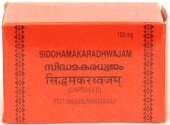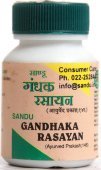Gandhaka, Gamdhaka: 20 definitions
Introduction:
Gandhaka means something in Hinduism, Sanskrit, Marathi, biology. If you want to know the exact meaning, history, etymology or English translation of this term then check out the descriptions on this page. Add your comment or reference to a book if you want to contribute to this summary article.
In Hinduism
Ayurveda (science of life)
Rasashastra (Alchemy and Herbo-Mineral preparations)
Source: Wisdom Library: Rasa-śāstra1) Gandhaka (गन्धक) is a Sanskrit technical term corresponding to “Sulphur”, which is a naturally occurring non-metallic chemical element (symbol S). It is commonly used in Rasaśāstra literature (Medicinal Alchemy) such as the Rasaprakāśasudhākara or the Rasaratna-samuccaya. Gandhaka is an ingredient often used in various Ayurvedic recipes and Alchemical preparations.
2) Gandhaka (गन्धक, “sulphur”):—One of the eight uparasa (‘secondary minerals’), a group of eight minerals, according to the Rasaprakāśasudhākara: a 13th century Sanskrit book on Indian alchemy, or, Rasaśāstra.
There are two varieties of Sulphur (gandhaka)
- Śvetagandhaka (‘white sulphur’),
- Pītagandhaka (‘yellow sulphur’),
- Raktagandhaka (‘red sulphur’),
- Kṛṣṇagandhaka (’black sulphur’)
3) Gandhaka (गन्धक) or Gandhakarasa is the name of an Ayurvedic recipe defined in the fourth volume of the Rasajalanidhi (chapter 3, grahaṇī: chronic diarrhoea). These remedies are classified as Iatrochemistry and form part of the ancient Indian science known as Rasaśāstra (medical alchemy). However, since it is an ayurveda treatment it should be taken with caution and in accordance with rules laid down in the texts.
Accordingly, when using such recipes (e.g., gandhaka-rasa): “the minerals (uparasa), poisons (viṣa), and other drugs (except herbs), referred to as ingredients of medicines, are to be duly purified and incinerated, as the case may be, in accordance with the processes laid out in the texts.” (see introduction to Iatro chemical medicines)
Source: Google Books: Alchemical TraditionsGandhaka (गन्धक, ‘sulfur’, lit.: “that which is aromatic”):—According to the Rasārṇava and Rasaratnasamucchaya, sulfur (gandhaka) is the menstrual emission of the great Goddess, which flowed into the Ocean of Milk while she was bathing there. When the Gods and Asuras later churned that ocean, her blood rose to the surface, together with the amṛta (“nectar of immortality”).
Source: archive.org: Rasa-Jala-Nidhi: Or Ocean of indian chemistry and alchemyGandhaka refers to “Sulphur”. (see Bhudeb Mookerji and his Rasajalanidhi)
Source: Indian Journal of History of Science: Rasaprakāśa-sudhākara, chapter 6Gandhaka (sulphur).—Four varieties of Gandhaka have been told by the ancient Sūrī (scholars):
- Śveta (white),
- Pīta (yellow),
- Rakta (red),
- Kṛṣṇa (black).
The Vipāka of sulphur is madhura, its Karmas are rasāyana, dīpana, viṣahā, rasaśoṣaṇa, sūtavīrya-prada (potentiates mercury-powers/effects), destroys kṛmiroga (worms), cures visarpa, kaṇḍu and kuṣṭharogas, and āmājīrṇa (indigestion due to āmādoṣa), if it is mixed with mercury definitely converts it into mūrcchita state (compound suitable for destroying diseases), its origin is similar to the menstrual flow of Goddess Pārvatī. As this very charming Sulphur is taken internally by the king Bali for acquiring more strength hence it is also called Balivasā.
It stimulates kāma (sexual desire), destroys kṣaya, pāṇḍu, duṣṭa-grahaṇī, śūlaroga, śvāsa and kāsa-roga, cures amājīrṇa (indigestion due to āmadoṣa) and induces laghutva (lightness) in the body and what more except lord Śaṅkara none else could describe the properties of sulphur.
Source: Ancient Science of Life: Critical Review of Rasaratna SamuccayaGandhaka (गन्धक) refers to “sulphur”, and mentioned in the Rasaratnasamuccaya: a 13th century C.E. alchemical treatise, authored by Vāgbhaṭa, is a useful compilation related to preparation and properties of drugs of mineral and metallic origin.
Kalpa (Formulas, Drug prescriptions and other Medicinal preparations)
Source: archive.org: Science And Technology In Medievel India (kalpa)Gandhaka (गन्धक) or Gandhakakalpa refers to Kalpa (medicinal preparation) described in the Auṣadhikalpa, as mentioned in A. Rahman’s Science and Technology in Medievel India: A bibliography of source materials in Sanskrit, Arabic and Persian.—Ancient and medieval India produced a wide range of scientific manuscripts and major contributions lie in the field of medicine, astronomy and mathematics, besides covering encyclopedic glossaries and technical dictionaries.—The Auṣadhikalpa is a medical work of the type of Materia Medica giving twenty-six medical preparations [e.g., Gandhaka-kalpa] to be used as patent medicines against various diseases.
Unclassified Ayurveda definitions
Source: Ancient Science of Life: Vaidyavallabha: An Authoritative Work on Ayurveda TherapeuticsGandhaka (गन्धक) refers to “sulphur” and is mentioned as an ingredient of metallic drugs for the treatment of Pāma and Dadru, as mentioned in the 17th-century Vaidyavallabha (chapter 3 and 8) written by Hastiruci.—The Vaidyavallabha is a work which deals with the treatment and useful for all 8 branches of Ayurveda. The text Vaidyavallabha (mentioning gandhaka) has been designed based on the need of the period of the author, availability of drugs during that time, disease manifesting in that era, socio-economical-cultural-familial-spiritual-aspects of that period Vaidyavallabha.
Source: gurumukhi.ru: Ayurveda glossary of termsGandhaka (गन्धक):—[gandhakaṃ] Element sulphur with chemical symbol S with At. no 16

Āyurveda (आयुर्वेद, ayurveda) is a branch of Indian science dealing with medicine, herbalism, taxology, anatomy, surgery, alchemy and related topics. Traditional practice of Āyurveda in ancient India dates back to at least the first millenium BC. Literature is commonly written in Sanskrit using various poetic metres.
General definition (in Hinduism)
Source: WikiPedia: HinduismIn the rasaśāstra tradition, sulfur is called gandhaka (गन्धक, literally “the smelly”). Indian alchemists, practitioners of “the science of mercury” (sanskrit rasaśāstra, रसशास्त्र), wrote extensively about the use of sulfur in alchemical operations with mercury (rasa), from the eighth century AD onwards.
Biology (plants and animals)
Source: Google Books: CRC World Dictionary (Regional names)Gandhaka in India is the name of a plant defined with Moringa ovalifolia in various botanical sources. This page contains potential references in Ayurveda, modern medicine, and other folk traditions or local practices It has the synonym Moringa moringa Small (among others).
Example references for further research on medicinal uses or toxicity (see latin names for full list):
· Synopseos Plantarum (Persoon) (1805)
· Prodr. (DC.) (1825)
· Neue und wenig bekannte Pflanzen Deutsch-SüdwestAfrikas (1914)
· De Fructibus et Seminibus Plantarum (1791)
· Bulletin de la Société Botanique de France (1963)
· Flora Reipublicae Popularis Sinicae (1984)
If you are looking for specific details regarding Gandhaka, for example side effects, health benefits, diet and recipes, pregnancy safety, chemical composition, extract dosage, have a look at these references.

This sections includes definitions from the five kingdoms of living things: Animals, Plants, Fungi, Protists and Monera. It will include both the official binomial nomenclature (scientific names usually in Latin) as well as regional spellings and variants.
Languages of India and abroad
Marathi-English dictionary
Source: DDSA: The Molesworth Marathi and English Dictionarygandhaka (गंधक).—m (S) Sulphur. 2 A certain medicinal compound.
Source: DDSA: The Aryabhusan school dictionary, Marathi-Englishgandhaka (गंधक).—m Sulphur.
Marathi is an Indo-European language having over 70 million native speakers people in (predominantly) Maharashtra India. Marathi, like many other Indo-Aryan languages, evolved from early forms of Prakrit, which itself is a subset of Sanskrit, one of the most ancient languages of the world.
Sanskrit dictionary
Source: DDSA: The practical Sanskrit-English dictionaryGandhaka (गन्धक).—Sulphur.
Derivable forms: gandhakaḥ (गन्धकः).
Source: Cologne Digital Sanskrit Dictionaries: Shabda-Sagara Sanskrit-English DictionaryGandhaka (गन्धक).—m.
(-kaḥ) 1. Sulphur. 2. The morunga tree, (M. hyperanthera, &c.) see śobhāñjana. E. kan added to the preceding.
Source: Cologne Digital Sanskrit Dictionaries: Cappeller Sanskrit-English DictionaryGandhaka (गन्धक).—[feminine] ikā smelling of (—°).
Source: Cologne Digital Sanskrit Dictionaries: Monier-Williams Sanskrit-English Dictionary1) Gandhaka (गन्धक):—[from gandha] mf(ikā)n. ifc. ‘having the smell of, scenting’ See aja-, avi-
2) [v.s. ...] m. ([gana] sthūlādi, [Gaṇaratna-mahodadhi 182]) ‘perfumes’ See -peṣikā
3) [v.s. ...] sulphur
4) [v.s. ...] Hyperanthera Moringa, [cf. Lexicographers, esp. such as amarasiṃha, halāyudha, hemacandra, etc.]
Source: Cologne Digital Sanskrit Dictionaries: Yates Sanskrit-English DictionaryGandhaka (गन्धक):—(kaḥ) 1. m. Sulphur; Morunga.
[Sanskrit to German]
Sanskrit, also spelled संस्कृतम् (saṃskṛtam), is an ancient language of India commonly seen as the grandmother of the Indo-European language family (even English!). Closely allied with Prakrit and Pali, Sanskrit is more exhaustive in both grammar and terms and has the most extensive collection of literature in the world, greatly surpassing its sister-languages Greek and Latin.
Kannada-English dictionary
Source: Alar: Kannada-English corpusGaṃdhaka (ಗಂಧಕ):—[noun] a pale-yellow, non-metallic chemical element found in crystalline or amorphous form, which burns with a blue flame and a stifling odour and is used in vulcanizing rubber and in making matches, paper, gunpowder, insecticides, sulphuric acid, etc. (symbol, S; at. wt., 32.064; at. no., 16; sp. gr. 2.07); sulphur; brimstone.
Kannada is a Dravidian language (as opposed to the Indo-European language family) mainly spoken in the southwestern region of India.
See also (Relevant definitions)
Starts with (+5): Gamdakagutike, Gamdhakacora, Gamdhakadhriti, Gamdhakallu, Gamdhakamla, Gamdhakarike, Gamdhakataila, Gandhakadi, Gandhakakalpa, Gandhakako-tejaba, Gandhakali, Gandhakalika, Gandhakandaka, Gandhakapeshika, Gandhakaraka, Gandhakarandaka, Gandhakarasa, Gandhakarasayana, Gandhakari, Gandhakarika.
Ends with (+9): Amragandhaka, Ashtamukhigamdhaka, Atigandhaka, Atmagandhaka, Avalyagandhaka, Dudhagandhaka, Hridyagandhaka, Krishnagandhaka, Kruragandhaka, Mittagandhaka, Mridugandhaka, Mukhagandhaka, Pancasugandhaka, Panchasugandhaka, Pitagandhaka, Raktagandhaka, Rasagandhaka, Rukshagandhaka, Sagandhaka, Samagandhaka.
Full-text (+34): Mukhagandhaka, Raktagandhaka, Sugandhaka, Samagandhaka, Avalyagandhaka, Gandhakapeshika, Shubhagandhaka, Rukshagandhaka, Amragandhaka, Rasagandhaka, Shvetagandhaka, Pitagandhaka, Krishnagandhaka, Gamdhaka, Trigandhaka, Gandhak, Kantakamalai, Kentakaveti, Kruragandhaka, Tikshnashigru.
Relevant text
Search found 9 books and stories containing Gandhaka, Gamdhaka, Gaṃdhaka; (plurals include: Gandhakas, Gamdhakas, Gaṃdhakas). You can also click to the full overview containing English textual excerpts. Below are direct links for the most relevant articles:
Jivanandana of Anandaraya Makhin (Study) (by G. D. Jayalakshmi)
Analysis of Goddess Parameśvarī < [Chapter 6 - Dramatic aspects of the Jīvanandana Nāṭaka]
Analysis of Lord Parameśvara < [Chapter 6 - Dramatic aspects of the Jīvanandana Nāṭaka]
Āyurvedic aspects of Act I < [Chapter 4 - Āyurvedic principles in Jīvanandana Nāṭaka]
Rasa Jala Nidhi, vol 2: Minerals (uparasa) (by Bhudeb Mookerjee)
Part 2 - Purification of Gandhaka < [Chapter VIII - Uparasa (9): Gandhaka (sulphur)]
Part 3 - How to take gandhaka < [Chapter VIII - Uparasa (9): Gandhaka (sulphur)]
Part 5 - Dietary prescriptions when taking Gandhaka < [Chapter VIII - Uparasa (9): Gandhaka (sulphur)]
Rasa Jala Nidhi, vol 1: Initiation, Mercury and Laboratory (by Bhudeb Mookerjee)
Part 16 - Mercurial operations (14): Exhaustion of mercury (yarana) < [Chapter IV-V - Mercurial operations]
Part 12 - Mercurial operations (10): Swallowing of metals of Mercury (grasana) < [Chapter IV-V - Mercurial operations]
Part 3 - Drawing of a hexagonal lotus diagram < [Chapter II - Initiation of Disciple]
Rasa Jala Nidhi, vol 4: Iatrochemistry (by Bhudeb Mookerjee)
Part 18 - Treatment of Piles (17): Shila-gandhaka vataka < [Chapter V - Piles]
Part 60 - Treatment for chronic diarrhea (32): Gandhaka rasa < [Chapter III - Jvaratisara fever with diarrhoea]
Rasa Jala Nidhi, vol 3: Metals, Gems and other substances (by Bhudeb Mookerjee)
Part 4 - Nectarization of lead < [Chapter VII - Metals (7): Sisaka (lead)]
Part 8 - Incineration of iron (27-34) < [Chapter IV - Metals (4): Lauha (iron)]
Atharvaveda and Charaka Samhita (by Laxmi Maji)
Rasendrasāra Saṅgraha (Āyurveda book) < [Chapter 1 - Introduction]
5b. Kṛmi (Worms) in the Atharvaveda < [Chapter 5 - Diseases and Remedies in Atharvaveda and Caraka-Saṃhitā]
3b. Udararoga (Udara disease) in the Caraka-saṃhitā < [Chapter 5 - Diseases and Remedies in Atharvaveda and Caraka-Saṃhitā]
Related products
(+24 more products available)





